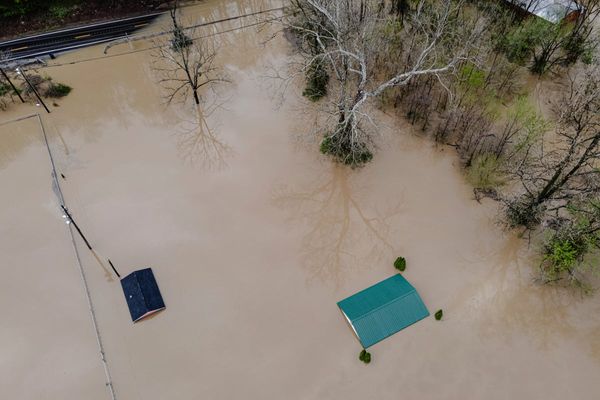On a muddy bank, basking in the Far North Queensland winter sun, a scaly predator lies silent and motionless.
But as the hum of a passing tinny approaches, it turns and slides quick-as-a-flash into the murky water.
This is life in Kowanyama, where First Nations people live side-by-side with crocodiles.
Kowanyama, which means "place of many waters", is home to 1,000 people. And, as the name implies, is surrounded by waterways, with the main Magnificent Creek running right past homes, shops and the local council office.
"If you see a crocodile out there and it's got a big shell on the forehead, that is the owner. She or he owns this land here," local elder and traditional owner Aunty Priscilla Major says.
"That's the spirit being for the people who have passed."
A safe distance from the water's edge at Topsy Creek, Aunty Priscilla sits under the shade of a tree, explaining the many Dreamtime totems in the waterways, including mim parrcherr — the saltwater crocodile.
Crocodiles are an intrinsic part of culture and stories in these parts, where murals and references to the reptile are sprinkled across town.
But fear also lurks just below the surface.
Former Indigenous ranger John Clark reminisces about his years in the region and the animal locals revere and fear the most.
"Crocs are moving around and our favourite spot that we used to go and drag for food and that sort of stuff. You can't go into that because there's a big croc sitting in there," he says.
"We don't mind a freshwater crocodile because we can just move him on, but the big saltie will put up a fight with you."
He explains that some older locals can smell the presence of a croc.
"They've got this sort of dry smell about them, but it really stinks sort of smell, and you know he's there," Mr Clark says.
"He might have had a carcass somewhere and kept it there for a while.
"That's probably about a couple of months old, but you can still smell the thing in the ground."
'They can hear you'
Kowanyama is the site of a former mission established in the early 1900s and taken over by the Queensland government in the 1960s.
These days, the shire still includes three Indigenous groups — the Kokoberra, Yir Yoront (or Kokomnjen) and Kunjen people, each with their own traditional language and culture.
It draws more tourists each year, but Aunty Priscilla worries many don't understand the dangers.
She recalls one family's close call.
"Those young fellas there were hitting the water and singing, 'Come on fishy fishy, come and get me fishy fishy'," she says.
"I said [to them], 'You'll die of fright instead of dying from that animal there, but [either way] you'll die when you see the shark come or crocodile grab you'.
'"Hitting the water, this is vibration. Crocodiles can be a long way away or sharks can be way out in the ocean, they can hear you. They'll come for you alright, and don't say I didn't warn you'."
Locals sometimes get caught off-guard too.
Last year, children swimming in Magnificent Creek were forced to climb a tree when they were approached by what was described as 5-metre crocodile that was later killed by Queensland Parks and Wildlife Service (QPWS) rangers.
Mr Clark has a theory.
"[The crocodile] came up and followed the watercourse all the way up here, probably he could smell in the water that there's something up there," he says.
As Aunty Priscilla explains, the locals' relationship with the minya — or story crocodiles — would be forever changed if someone were to be taken.
"You pollute this water with blood, your blood going to spill here, we will never be the same," she says.
"We can't even sit here; crocodile will be there waiting for us."
Life source of a community
Kokoberra teenager Chantira David has spent her childhood being out on country and fishing for bush tucker.
Not long ago, she says she had a close encounter of her own on a fishing trip.
"As I was pulling my fish up, the croc was coming towards me. The croc was chasing my fish," she says.
"When I've seen the croc right near the bank, I got a big fright and I jumped up, ran up the bank and I left my fish and line there."
The 15-year-old, however, was determined not to let her prized catch get away.
"We cook our fish straight on the coal, have our damper," she says.
"It tastes so delicious."
Chantira's totems are black snake and stingray.
"When we were babies in our mum's belly, our mum would catch a crocodile or barra or snake or whatever we see, and then that's a sign for a baby," she says.
"Some people's totem is crocodile. If they had the totem to the crocodile, then it's just like they're a crocodile too."
Like everyone else in town, she's always on the lookout.
"When you go near the water, that crocodile, he can see you from miles away," she says.
"The water behind me, there's a big crocodile in there what we call a big Minya.
"Story Croc means that it's the story of the place."







